Cold hibernation of tortoises (torpor) is particularly safe in a separate hibernation refrigerator and is recommended in expert training courses and by reptile veterinarians. Ensuring the correct hibernation parameters will ensure the wellbeing of the animals during this resting period.
Which European tortoises hibernate?
Hermann’s tortoises (Testudo hermanni) from the eastern and western subspecies, Marginated tortoises (Testudo marginata) and some Testudo graeca subspecies, such as Eurasian tortoises (Testudo graeca ibera), are hibernating species. In Hermann’s tortoises, hibernation lasts about 16 weeks, in Eurasian tortoises about 12 weeks.
Horsfield’s tortoises (Testudo horsfieldii) also hibernate, in addition to summer aestivation. Although they do not belong to the European tortoises, we do not want to leave them unmentioned. Horsfield’s tortoises need a drier hibernation and tolerate somewhat cooler temperatures than European tortoises. Moisture does not agree with them, which is why they are occasionally overwintered in straw instead of soil and leaves.
The advantages of hibernation in the refrigerator
In contrast to the usage of a hibernation pit, hibernating in the refrigerator allows for a short monthly check up of the animals. Many keepers who do not have a hibernation pit secured against frost and predators opt for refrigerator hibernation. Compared to hibernation in the hibernation pit, the lack of threat from predators, the lower technical effort to secure the temperatures, and the possibility to check the health of the animals during hibernation are advantages. The transfer of the animals from their cold frame to the refrigerator and vice versa usually does not cause them any stress. In addition to that, the animals generally do not notice the monthly checkups and weighing either.
When should hibernation be avoided?
There are some exclusion criteria for hibernation: These include females that have not laid their eggs and animals that are acutely ill or have undergone surgery. It is vital that the tortoise is free of intestinal parasites before it goes into torpor. If a faecal examination for intestinal parasites has not been carried out, it should be done before the wind-down period. Recently dewormed animals should be kept at high summer temperatures for six weeks after the end of the deworming treatment, to allow the medication to break down and the parasites to be eliminated. It is recommended to have a worm count carried out every summer, and deworming the animals even in case of a minor parasitic infestation. For animals with chronic metabolic problems that need treatment, a blood count is usually done. Following the doctor’s instructions, medication is „phased out“ before the temperature in the cold frame is lowered.
It is advisable to take the tortoises to a reptile vet in autumn for a hibernation check. This is especially recommended for animals that are hibernating for the first time, or that come from poor husbandry. Animals with infectious underlying diseases and from different stock should not be hibernated together in the same refrigerator.
If everything is in order and the tortoise is ready to hibernate, certain preparations and safety measures should be taken before refrigerator hibernation.
The process of a refrigerator hibernation
The first step is to select the refrigerator, the hibernation boxes, and the appropriate location. The second step consists of bringing the refrigerator into the optimal temperature range, and securing it against temperatures that are too low. After that, the tortoises are transferred to the refrigerator. Now the refrigerator is ventilated regularly, and the substrate is moistened if necessary. This is followed by monthly checks. At the end of the hibernation period, the tortoises are transferred back to their cold frame. We will now go over these individual steps in detail.
Choosing a refrigerator, boxes, and location
The first thing to do is to choose sturdy plastic boxes that suit the tortoises.
The tortoises are hibernating individually. Each animal gets its own box in which it has enough room to turn around. There should be at least two shell heights of soil and just as much beech leaves. The animal should be able to bury itself completely in the substrate.
It is practical to buy lids to go with the boxes. These can later be fitted with a grid to ensure the necessary air exchange, and to prevent the animals from falling out of the box.
Due to their small size, hatchlings can be overwintered together in one box, as they hardly disturb each other, and the temperatures remain more constant in a larger box with more soil and foliage. If few animals are housed in the refrigerator, it is advisable to choose the largest possible overwintering boxes. The larger the boxes, the more soil and foliage will fit inside, and the more constant the temperatures will remain on the animal. The insulating effect of the foliage and soil significantly reduces temperature peaks during ventilation and cooling.
When buying a refrigerator, you can take the boxes with you to the electrical shop to see if everything fits comfortably into the desired appliance. The refrigerator should be as large as possible, so that it accommodates the growth of the animals. With larger air volume, the temperatures are also more constant, and there are more options for placing the boxes in it.
As a separate hibernation refrigerator, a large full-capacity refrigerator without a freezer or ice compartment is recommended. In appliances with a freezer compartment, it is possible, that the contents of the fridge freeze over in a short time in the event of a defect due to the strong cooling capacity.
It is important to have a so-called „no-frost function“ that automatically defrosts the refrigerator and prevents ice formation. A recirculation function ensures particularly stable temperatures in the appliance. When buying, the width of the unit should be kept in mind, to provide as much space as possible for the overwintering boxes. The boxes must not touch the walls of the refrigerator, especially the back wall, as the substrate can freeze over otherwise.
The refrigerator should be placed in a heated room with a room temperature of at least 16 degrees, as most refrigerator thermostats do not work reliably below this room temperature due to their climate class.
After transport, the refrigerator should first rest for 24 hours so that the coolant can flow back before it is put into use. The door shelves can be removed to leave more room for the boxes in the refrigerator.
It is also a good idea to switch off, or put tape over the lights, so that the animals are not disturbed unnecessarily.
Preparing the hibernation boxes
First, holes are drilled all around the bottom of the hibernation box to prevent waterlogging. Then the boxes are wrapped all around with bubble wrap or aluminium lamination to minimize temperature fluctuations. Regarding frost, Styrofoam, and a spacer, for example an adhesive hook, can be attached to the back of the boxes so that the back wall is not touched under any circumstances.
For good ventilation, the lid of the box should be sawn out at least hand-size in the inner area. A grille should be attached to it from the outside, for example with cable ties. Then the animals cannot accidentally fall out and injure themselves during a longer power failure.
Substrate and foliage
The hibernation box is filled with at least two carapace heights of substrate, and as much foliage as possible.
Use loose, sieved topsoil or commercially available tortoise soil. Foliage from beeches, hornbeams and oaks is well suited because it is stable, does not stick and does not tend to mould.
A thick, loose layer of foliage on top of the soil provides good insulation against temperature fluctuations.
A reserve supply can be kept in a cool place in case fresh substrate or foliage is ever needed for replacement.
Technology for safe refrigerator hibernation
A UT300 universal thermostat (Equiva) guarantees safe hibernation, as it is switched in front of the refrigerator as an emergency stop. In case of a technical defect, it is the „life insurance“ for the tortoises hibernating in the refrigerator.
To set the refrigerator to the correct temperature range, one probe thermometer for each hibernation box is necessary. When choosing such a thermometer, it is important to have a resettable minimum-maximum temperature measurement and a frost alarm.
A modern method of temperature control is the smart thermometer system WeatherHub from TFA Dostmann. It consists of a gateway and sensors that radio to the gateway. Via the gateway, the temperatures are fed into an app. This allows you to monitor the temperatures via your mobile phone and receive notifications if the temperature deviates from the target range. Alternatively, radio thermometers with temperature alarms are recommended, which also alert you if the power fails. The WeatherHub cannot do this, so an additional radio thermometer in the coldest box makes sense in any case. Furthermore, a digital household scale is needed to check the weight of the animals every four weeks.
Preparing the refrigerator
As soon as the basic temperature in the cold frame is lowered over several weeks, following the climate in the habitat, you also begin to prepare your refrigerator. The complete preparation and securing of the refrigerator are always done without animals. First, set the refrigerator to the warmest setting. The probe thermometers are placed on the refrigerator, the sensor cables are led through the door and protected with duct tape. One thermometer per box is needed. The sensor is placed in the back of the box under the foliage, slightly buried in the soil. It is important to measure the temperatures at the back, as it gets colder towards the back of the fridge. This way you get an overview of the temperature zones in the refrigerator and determine the coldest place in the appliance. Later, the sensor of the UT300 universal thermostat is placed in the box at the coldest spot.
First, the prepared box is left to come to temperature for a few days. After that, make a daily note of the minimum-maximum temperatures of each box and then reset them with the „Reset“ button. The prepared boxes are now brought to a temperature range between 4.5 and 7 degrees by gradually regulating the fridge thermostat. Ideally, temperatures would be between 4.5 and 6 degrees, but this is not always feasible, when the refrigerator is fully occupied, due to the temperature gradient. Temperatures should not drop below 4 degrees when hibernating European tortoises. At 8 degrees, the tortoises‘ metabolism starts to run again.
If the refrigerator is too warm in the warmest setting, it should be set a little colder.
It is helpful to mark the old setting of the refrigerator thermostat with a permanent marker so that you can roll back to the old setting if necessary. You can also try varying the height of the levels on which the boxes stand.
A few centimetres higher or lower can have the desired effect. If it is too cold in a box, you can pull it forward a bit, put Styrofoam at the back of the box or wrap it with bubble wrap. You can also fill the unused part of the refrigerator with sealed water bottles to stabilize the temperatures, but make sure that there is still enough air circulation. The use of refrigerator grates instead of shelves helps to equalize the temperatures in the refrigerator. The actual temperature in refrigerators with a digital temperature display fluctuates around the displayed value, so we also need to determine the actual temperatures in these appliances. After each change, the temperatures are observed for a few days and readjusted if necessary. Not later than one week before the transfer of the tortoises, the refrigerator should be in the desired temperature range of 4.5-7 degrees and secured with the UT300 thermostat.
Protection against low temperatures
To safeguard the tortoise refrigerator against defects, one traditionally uses an Equiva UT300 universal thermostat, because of the temperature range that can be set in tenths of a degree and the thin sensor cable.
It is only programmed after the above-described preparation of the refrigerator with temperature measurement by probe thermometer on each level without animals has been completed. Only then, the coldest level in the refrigerator has been determined, and the UT300 can be set accordingly. The thermostat only functions as an „emergency stop“, and should not be used to take over the refrigerator control. It is also useful to keep a spare thermostat on hand. The UT300 is plugged in between the power socket and the refrigerator plug. The sensor cable is fed through the fridge door and protected from crushing and cable breakage with duct tape. Then, the sensor is placed in the back of the box at the coldest point in the refrigerator, which was previously determined by the probe thermometers. Like mentioned previously, the sensor is inserted lightly into the substrate under the foliage. The temperatures are then set on the UT300, and „Cooling“ is shown on the display. Ideally, the refrigerator temperature is set so well, that the UT300 never has to turn off the refrigerator. This is also advantageous for the lifespan of the refrigerator. A small light, interposed by a multiple plug, indicates whether the refrigerator is on or off. If the minimum temperature in the coldest box is 4.8 degrees, for example, the sensor of the UT300 is put at this point at the back of this box. The „OFF“ temperature of the UT300 should be 0.2 degrees below the determined minimum temperature, i.e., it should only serve as an „emergency stop“. So, in this case, for example: minimum temperature 4.8, UT300 = OFF at 4.6.
However, do not set OFF below 4.2 degrees and do not set ON higher than 5.8 degrees. For example, if the maximum temperature is 6.8 degrees, set 5.8 degrees.
Maximum temperature 5.9 degrees = ON at 5.7 degrees (-0.2 degrees).
OFF should never be below 4.2 degrees, ON should never be above 5.8 degrees. Test in 0.1degree steps what suits the refrigerator best. Never go below 4.2 degrees in the coldest box. Continue to check the minimum-maximum temperatures daily. Caution: Some refrigerators cool down by up to one degree after they have been switched off.
If the refrigerator is challenging to regulate and becomes too cold despite being set on the warmest level, it should be controlled entirely using the UT300. It should be borne in mind that in the event of a defect in the UT300, there is a danger to the animals‘ lives. In this respect, this should only be done in an emergency and a new refrigerator should be purchased quickly. You could try the following setting, which has proven successful in such emergencies: OFF at 5.3 degrees, ON at 5.8 degrees. Monitor the refrigerator very well and remedy the situation as quickly as possible.
WeatherHub Installation
If you want to use a WeatherHub to keep an eye on the temperatures regardless of location, you connect the gateway to the internet router or connect it to WIFI via a Fritz Powerline socket. Then install the corresponding app and register the sensors. If there is no good radio reception between the sensors in the refrigerator and the gateway, you should move the gateway closer to the refrigerator. Attach the Pro sensors with 2 measuring points (integrated sensor and cable sensor) with duct tape in the foliage area and insert the probe sensor lightly into the substrate. These sensors are very practical as you can monitor air and substrate temperature at the same time. If you only have one sensor, it goes in the back of the coldest box to the sensor of the UT300. If you do not have a WeatherHub, you can use a radio thermometer with temperature alarm for local monitoring. You need one sensor per box. A strong radio signal and a temperature and frost alarm that can be set are important.
Moving the hibernating tortoises into the refrigerator
Before the end of November, it is usually not cold enough for hibernation in Germany. The temperatures must be below 8 degrees permanently. After at least one, or better 2 weeks at temperatures of 4-7 degrees, the animals can be moved into the prepared refrigerator during the evening. If a tortoise remains awake despite low temperatures, this should be discussed with a reptile vet. Animals that are awake should not be transferred. The time of resting in the cold frame is added to the total duration of hibernation. The hibernation box is removed from the refrigerator and the leaves placed in a separate container.
Weigh the tortoise. Then form a shallow hollow for the tortoise in the soil. Place the tortoise in the hollow with some soil from the spot where it was in the cold frame. Cover the carapax lightly with soil but leave the head area free. Then cover the tortoise with a thick layer of leaves. After that, attach the lattice lid firmly. Put the box in the fridge, and make sure that the sensor cables are still in the right place. It is often helpful to fix the sensors to the box and fridge with duct tape. Put one tortoise in the box at a time and close the fridge in the meantime. Make sure that the box does not touch the back wall of the refrigerator. After transferring the tortoises into their boxes, do not open the refrigerator for a few days. Ventilate the fridge briefly three to four times a week, or more frequently if the fridge is full or the animals are large. It is better to ventilate briefly more often instead of rarely and for a long time. Every ten days you should feel under the foliage: If the soil feels very dry, you can spray the foliage on the side with water from a flower spray bottle, which is also kept in the refrigerator. Do not spray on the middle of the foliage and only moisten lightly. If the leaves are moistened too much, the temperature in the refrigerator may drop. If this happens, hold back considerably the next time you humidify. Only ventilate the refrigerator again after three days. If the temperature drops below 4 degrees after humidifying and opening the refrigerator for a longer period, set the off temperature of the UT300 accordingly. After a few days, it can be reset to the previous value.
Weighing and checking
During controlled refrigerator hibernation, the animals are weighed and briefly checked once a month. In the last month of hibernation, it is advisable to check twice. Check on weekdays, so that a reptile vet is available in case of emergency. Have scales, paper, and pen ready and ventilate the room well. Set aside two containers for leaves and soil. Take the spray bottle with water out of the refrigerator. Place a chair or table next to the refrigerator so that the boxes higher up in the refrigerator can be checked on it without having to remove the sensor cables fixed to the box. Take each box out separately, then close the fridge immediately to keep the other animals at temperature. Dropped faeces and urate may occur occasionally and are usually not a cause for alarm. Weigh the tortoise and note the weight with the date. Then check the animal from each side for redness. Does the tortoise react to touch as if in slow motion? Are the nose, mouth, and eyes without discharge? If anything seems unusual, take photos to send to the reptile vet. After that, put the animal back in the refrigerator and discuss by phone whether action is needed. Put the substrate back into the hibernation box. If the substrate feels too dry, moisten it slightly with the spray bottle from the refrigerator and loosen it up. Then put the tortoise back in its burrow in the direction you found it, and again heap some soil over the hind legs and back. Like mentioned previously, leave the head area exposed. If the leaves are very dry and rustle, you can moisten them lightly with water from the spray bottle. The water must be refrigerated, otherwise the animals may wake up. Then put the leaves back on the animal and add the lattice cover. If you are hibernating several animals, wash your hands and clean the equipment before the next animal. If there has been a weight loss of more than five percent since the animal started hibernation, you should discuss with the reptile veterinarian whether the tortoise may continue to hibernate. In case of redness and spots on the plastron, remove the animal from the refrigerator in its box, put it in a cool place and contact the reptile veterinarian directly; this is an emergency. Proceed in the same way with animals that are sitting awake in the refrigerator despite the right temperatures.
Emerging from the refrigerator
When the tortoises‘ hibernation is coming to an end, you can take your time to check the technology in the cold frame. The heating, basking spot lamp and control system are put into operation and checked. This is an opportunity to loosen up the soil in the cold frame and, if necessary, to plant fresh feeder plants and Mediterranean shrubs. You can also use this opportunity to sow food plants directly in the cold frame. A few days before the tortoises are leaving the fridge, it is advisable to heat the cold frame to 25 degrees for a day. If the technology is working properly, stabilize the temperature in the cold frame at 8 degrees with the heating. Greenhouse fan heaters have proved successful for this purpose, as they heat the soil particularly evenly. The soil temperature in the cold frame can be easily checked with a laser thermometer. If possible, plan the end of hibernation in the evening during the week. If a health problem arises the day after coming out of hibernation, a reptile vet can be consulted immediately. Remove the hibernation box and weigh the animal, checking it visually. Then bring it to the cold frame in the refrigerator box. If you have several animals, take them out of the refrigerator one after the other.
In a corner of the cold frame, form a slight hollow in the soil, away from the lamp and heater. Then take the animal out of the box with some soil and place it in the hollow. The tortoise should face the basking spot.
You can also put some soil from the box on the back shell so that the animal warms up gradually. Leave the head area free. Then cover the tortoise with the leaves from the box. The heating in the cold frame remains at 8 degrees the first night and the next day we increase the ambient temperature to 12 degrees. Then we increase the basic temperature every day until 20 degrees are reached during the day. At night, the temperatures are lowered considerably, but not below 12 degrees. On the first day in the cold frame, offer 5 hours of sun directly, then 1 hour longer every day to finally offer a warm basking spot from sunrise to sunset. In the first week, the temperature under the basking spot should reach 35 degrees at the shell height of the largest animal. From the second week, temperatures under the basking spot may reach 38 degrees. If, contrary to expectations, a tortoise remains inactive and does not sunbathe or eat, the basic temperature is increased more quickly, this applies especially to the night temperature. For monitoring the basic temperature in the cold frame, the radio thermometers available from the refrigerator hibernation or the WeatherHub are well suited. The sensors can be placed at tortoise height in the cold frame, for example in a hiding plant. Within a few days, as the ambient temperatures rise, all animals should be basking, eating, and bathing. If this is not the case, it would be good to check with your reptile vet. It could be a health problem, such as post hibernal anorexia or other metabolic problems. I wish all European tortoises a good and safe controlled hibernation!
More info and exchange around controlled fridge hibernation can be found in this Facebook group Bit.ly/Starregruppe
Author & photos: Frauke Hustinx (if not indicated differently)
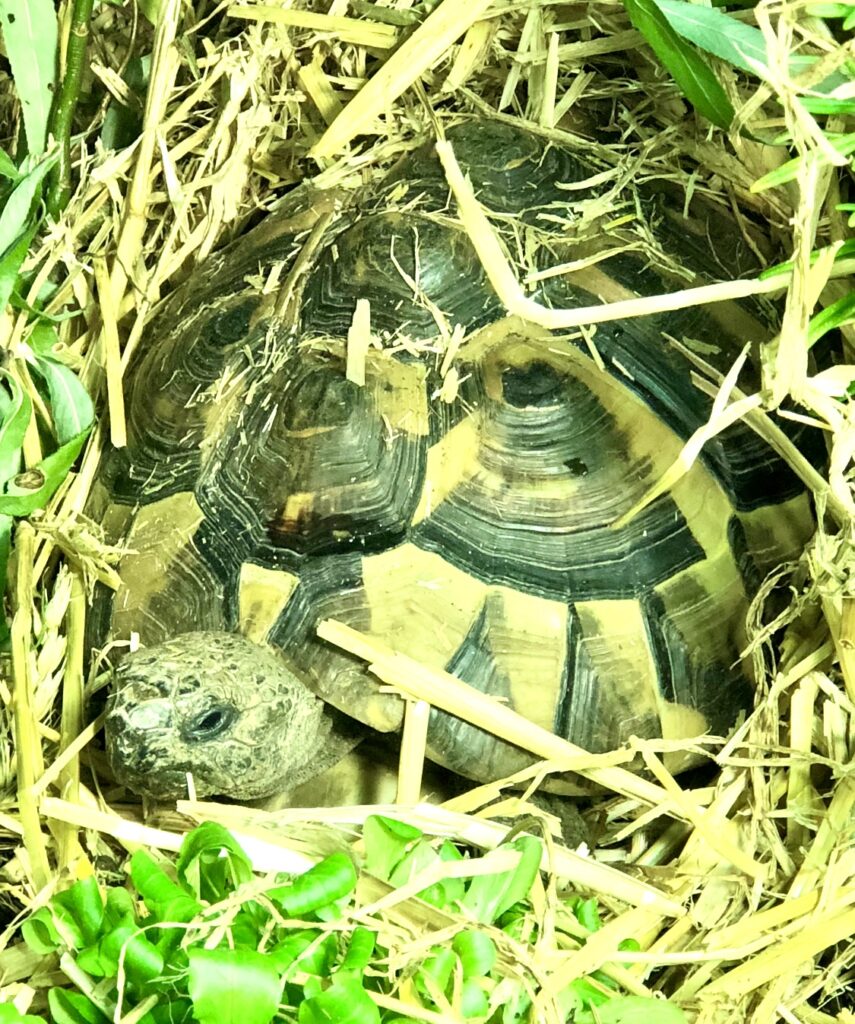
Fig. 1. Resting Hermann´s tortoise in preparation of hibernation.
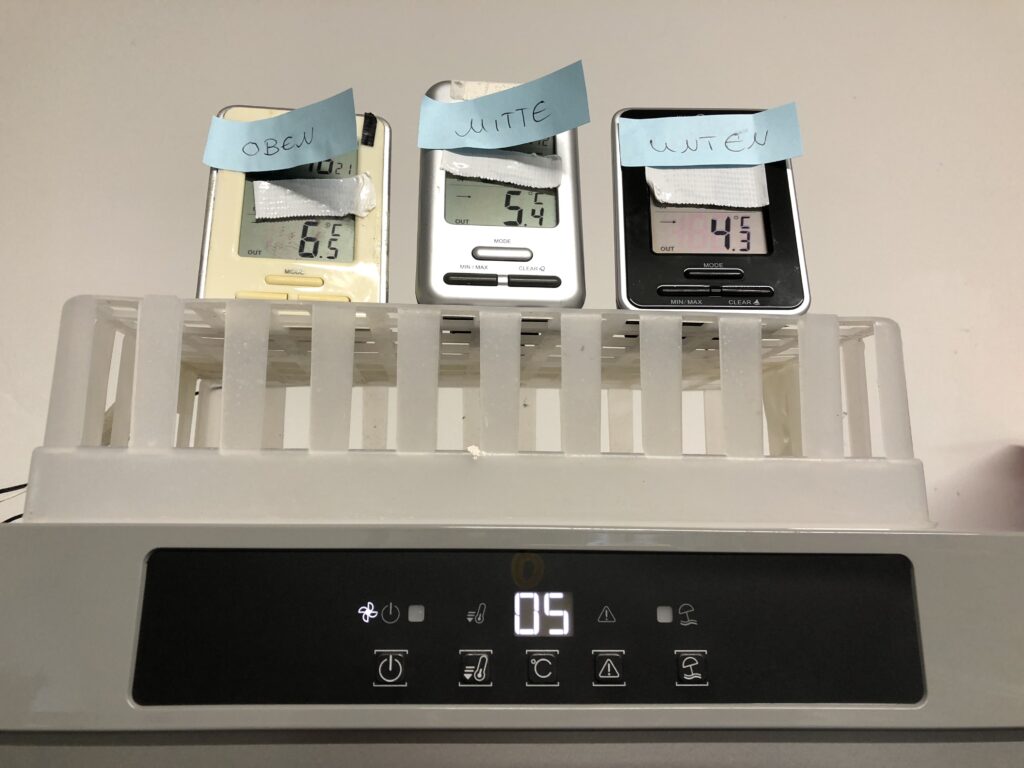
Fig. 2. Probe thermometer for preparing the refrigerator.
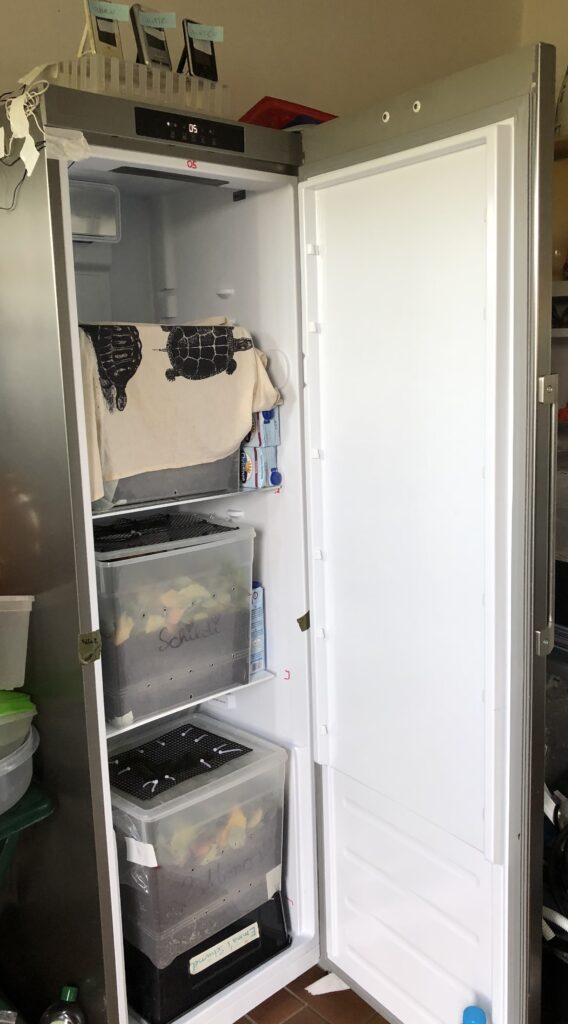
Fig. 3. Refrigerator with hibernation boxes.

Fig. 4. Prepared hibernation box with leaves.
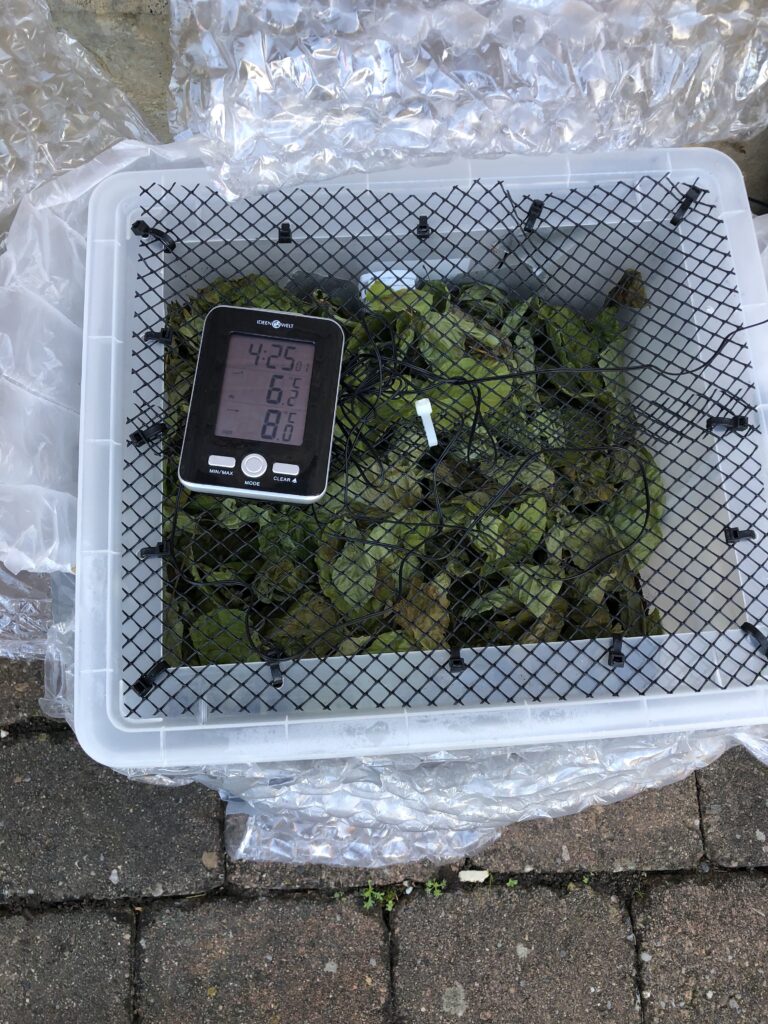
Fig. 5. Hibernation box with probe thermometer.
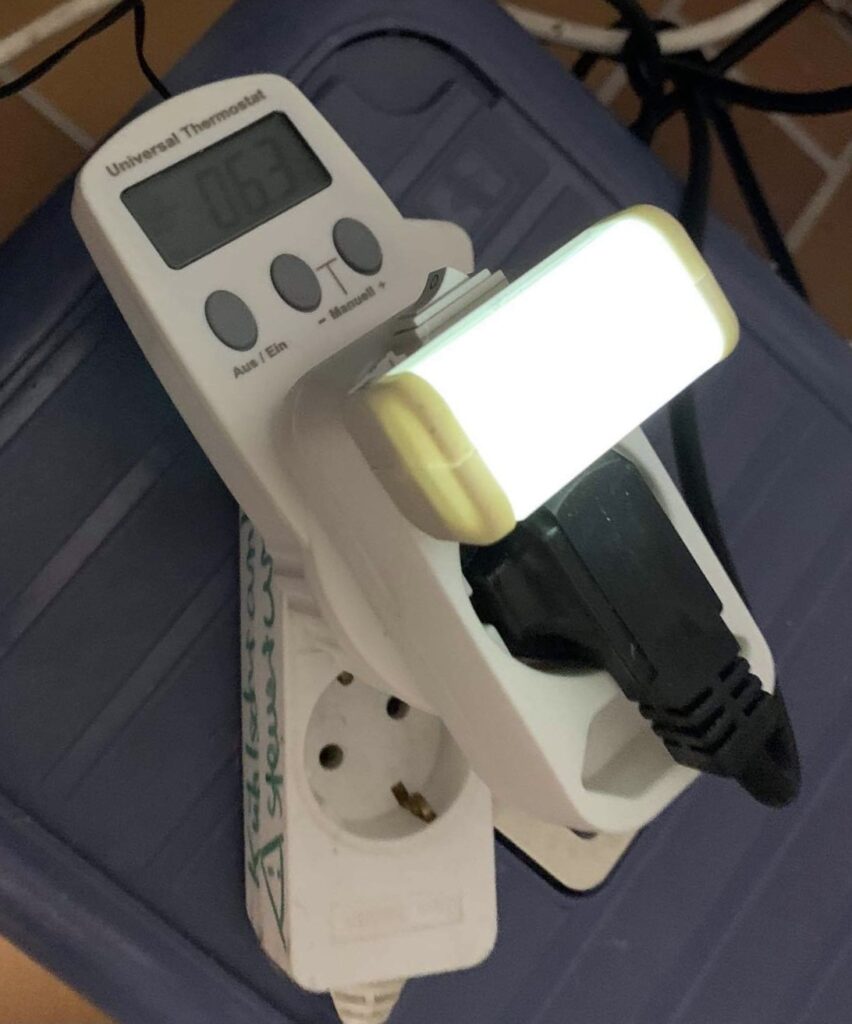
Fig. 6. Universal thermostat with control light.
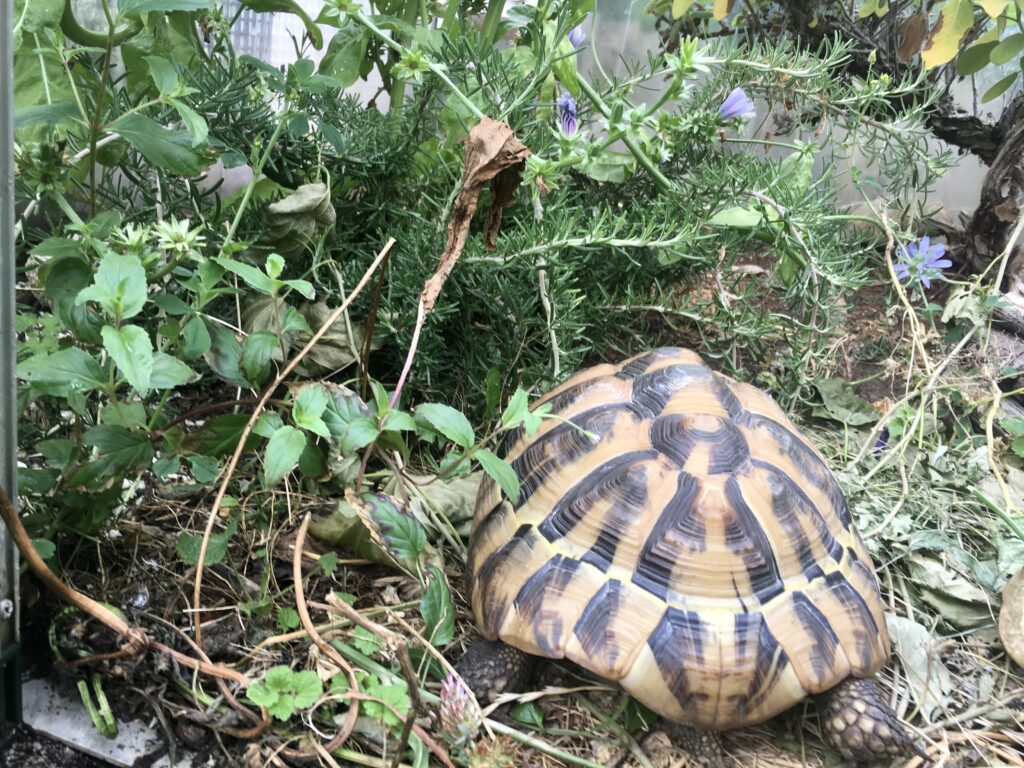
Fig. 7. Resting Hermann´s tortoise in the cold frame.
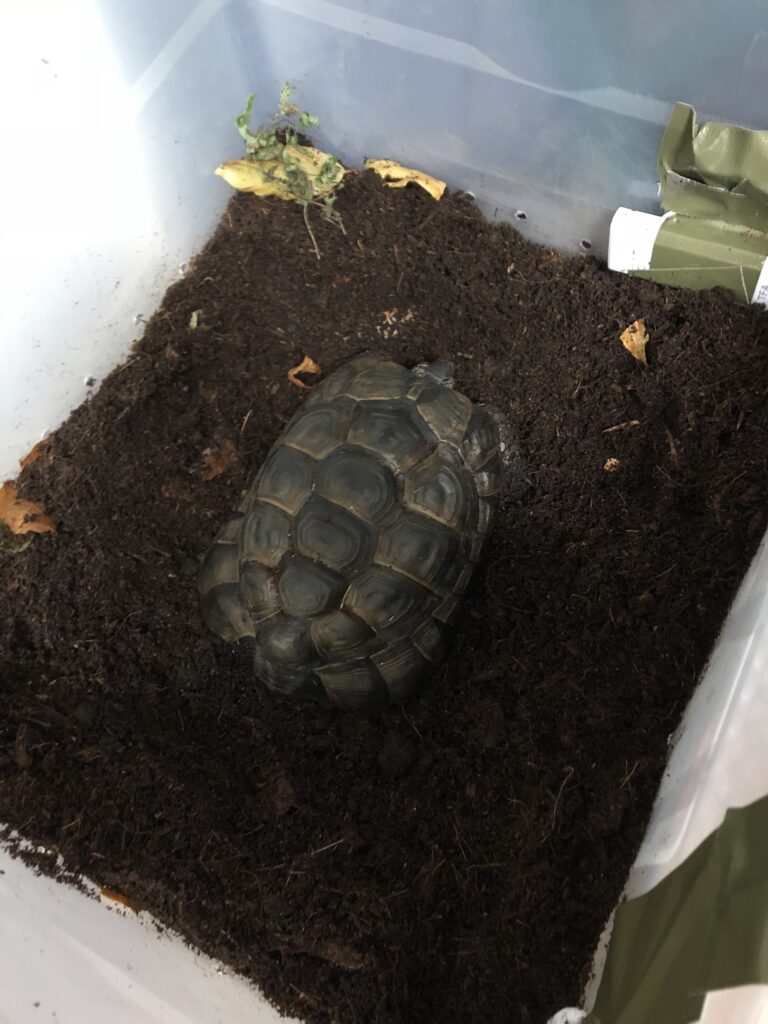
Fig. 8. Testudo graeca before entering the refrigerator.
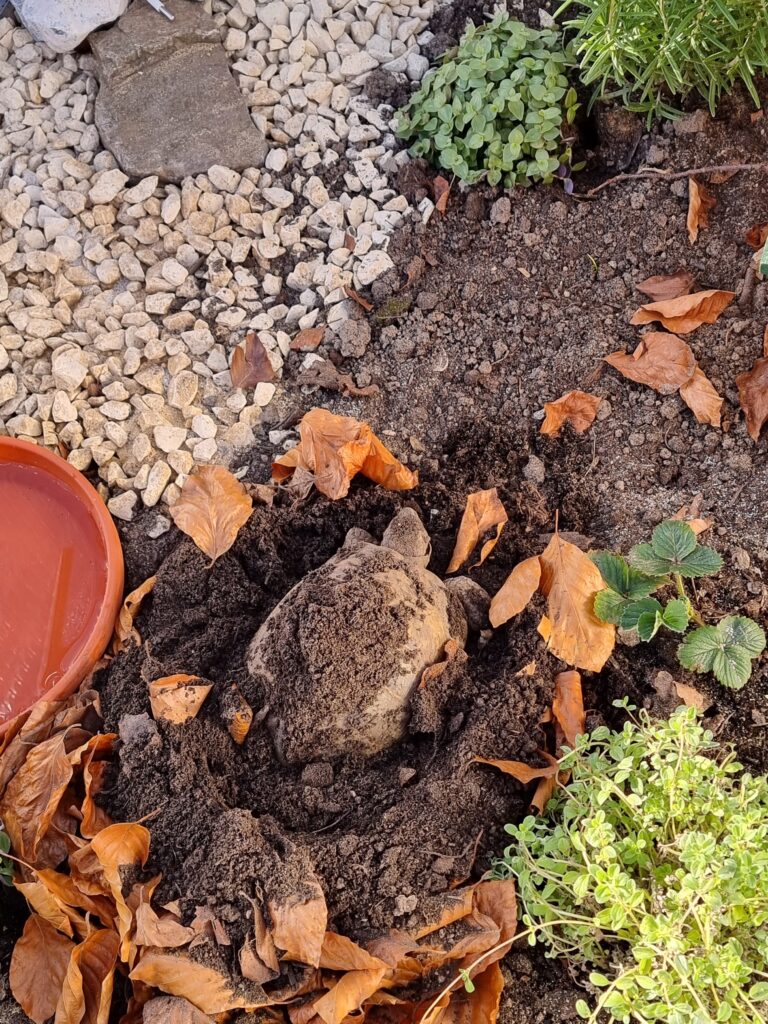
Fig. 9. Awakening Testudo horsfieldii in cold frame. (Yvonne Wießner-Scholl)
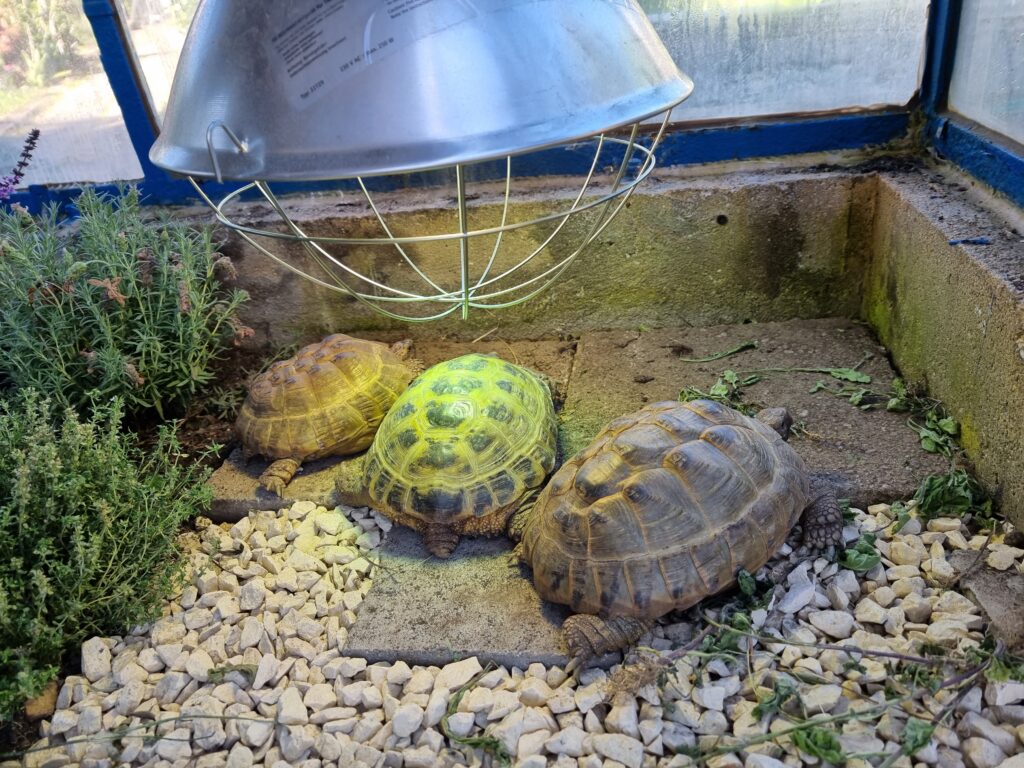
Fig. 10. Testudo horsfieldiis sunbathing after the hibernation. (Yvonne Wießner-Scholl)
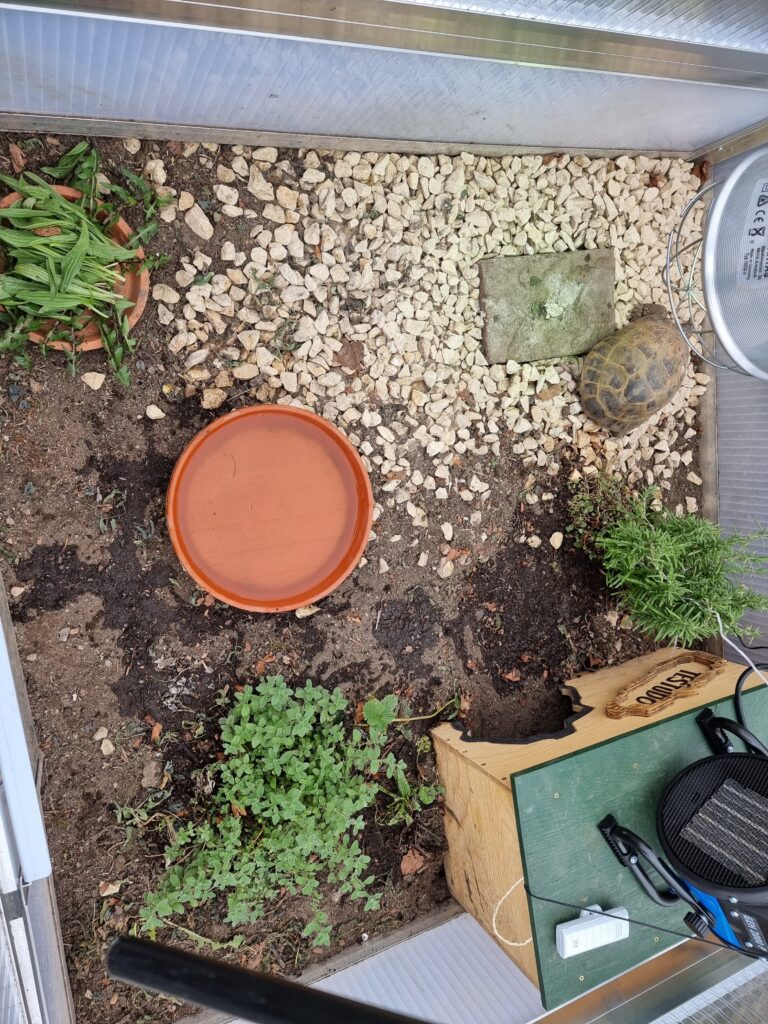
Fig. 11. Cold frame, equipped with greenhouse-heater and basking-spot. (Yvonne Wießner-Scholl)
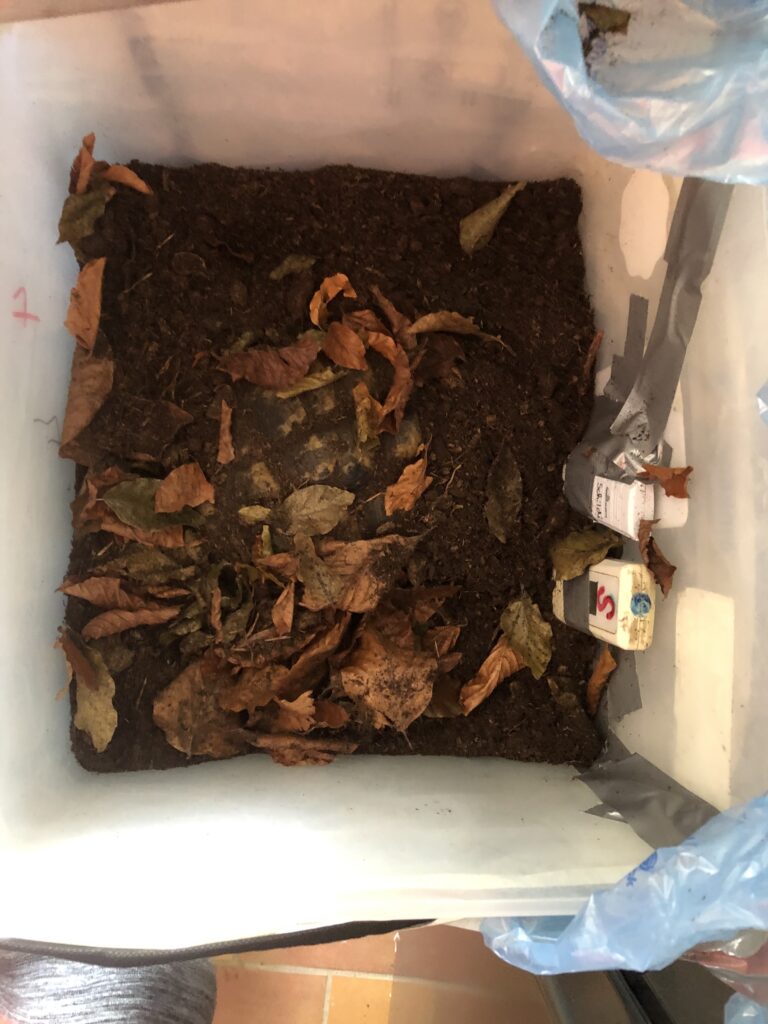
Fig. 12. Coming out of the refrigerator.
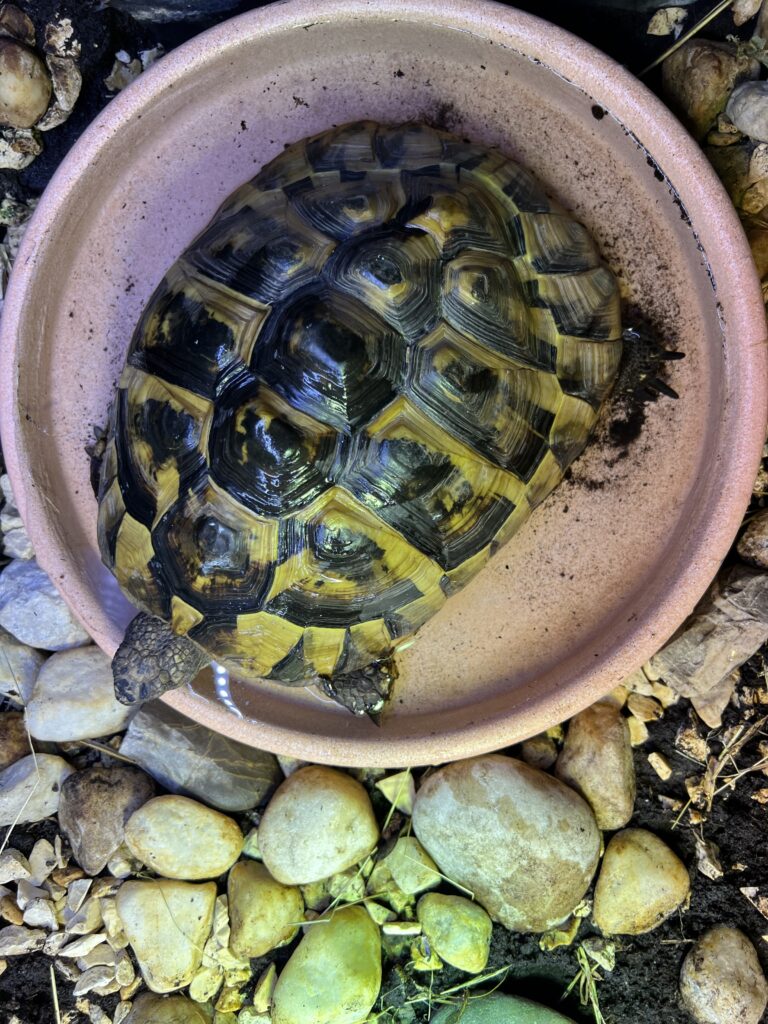
Fig. 13. Bathing Hermann´s tortoise.
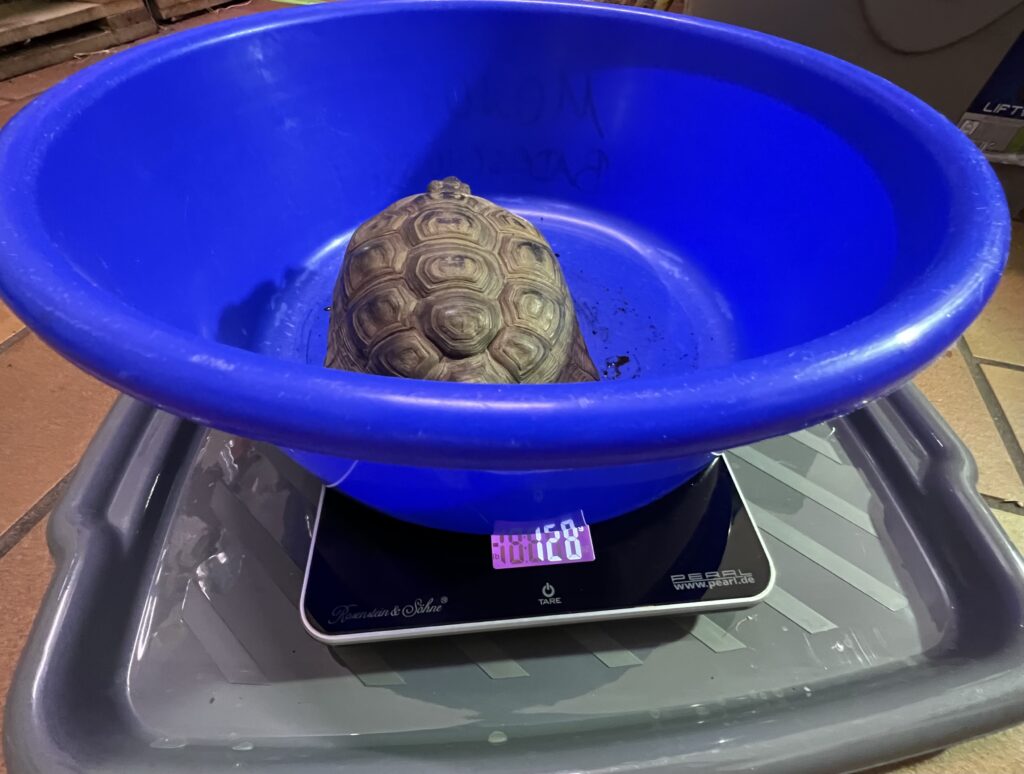
Fig. 14. During the weight check.
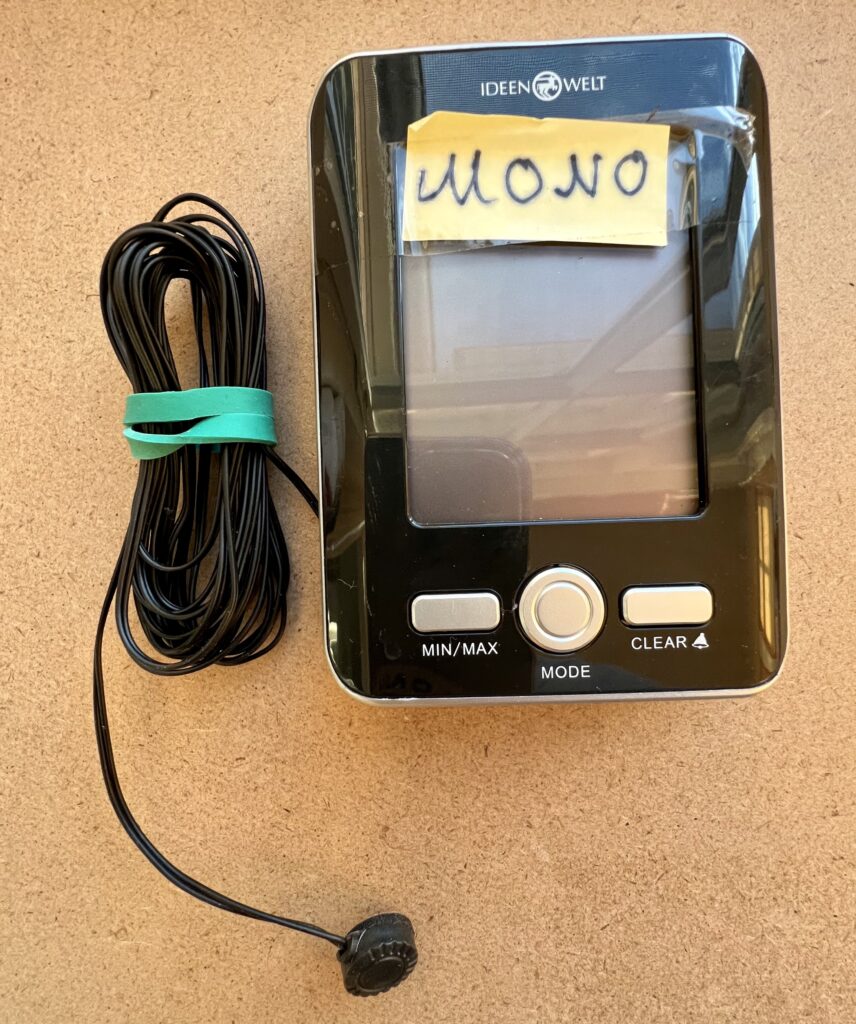
Fig. 15. Probe thermometer.
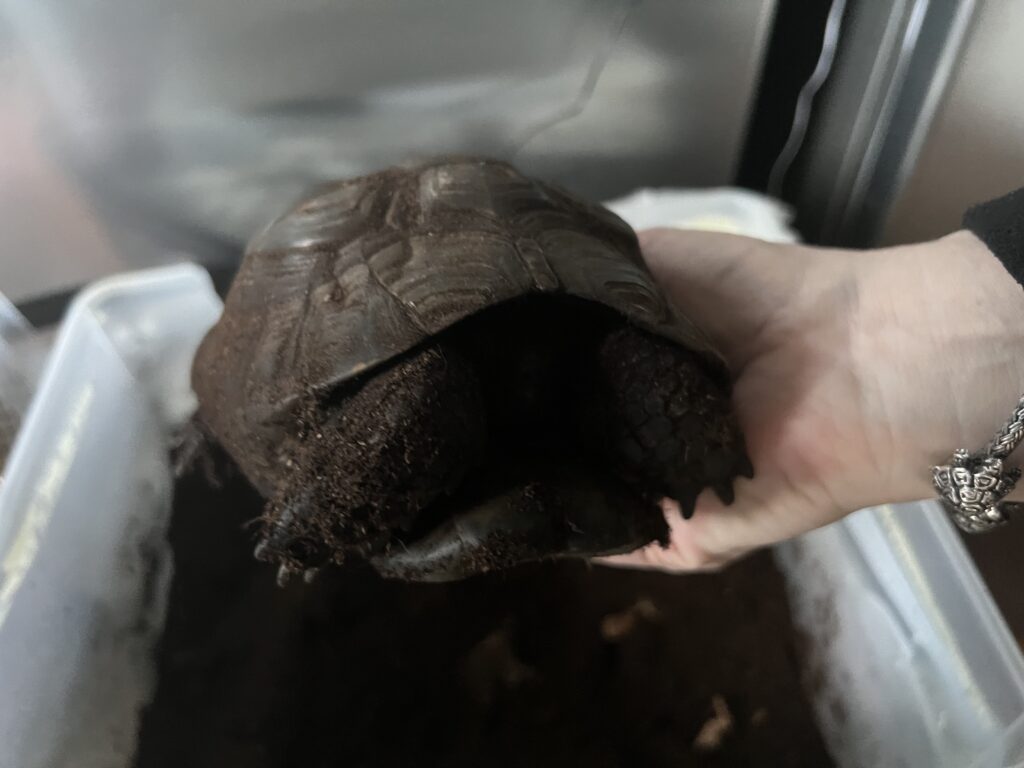
Fig. 16. End of hibernation.
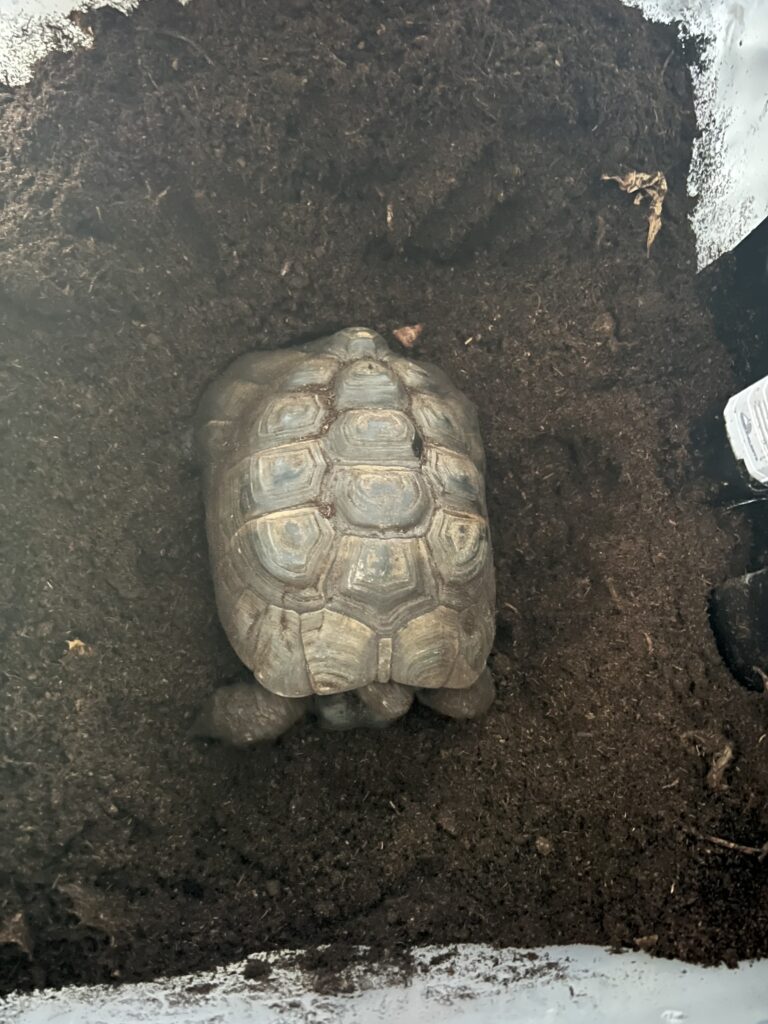
Fig. 17. Testudo graeca in hibernation box.
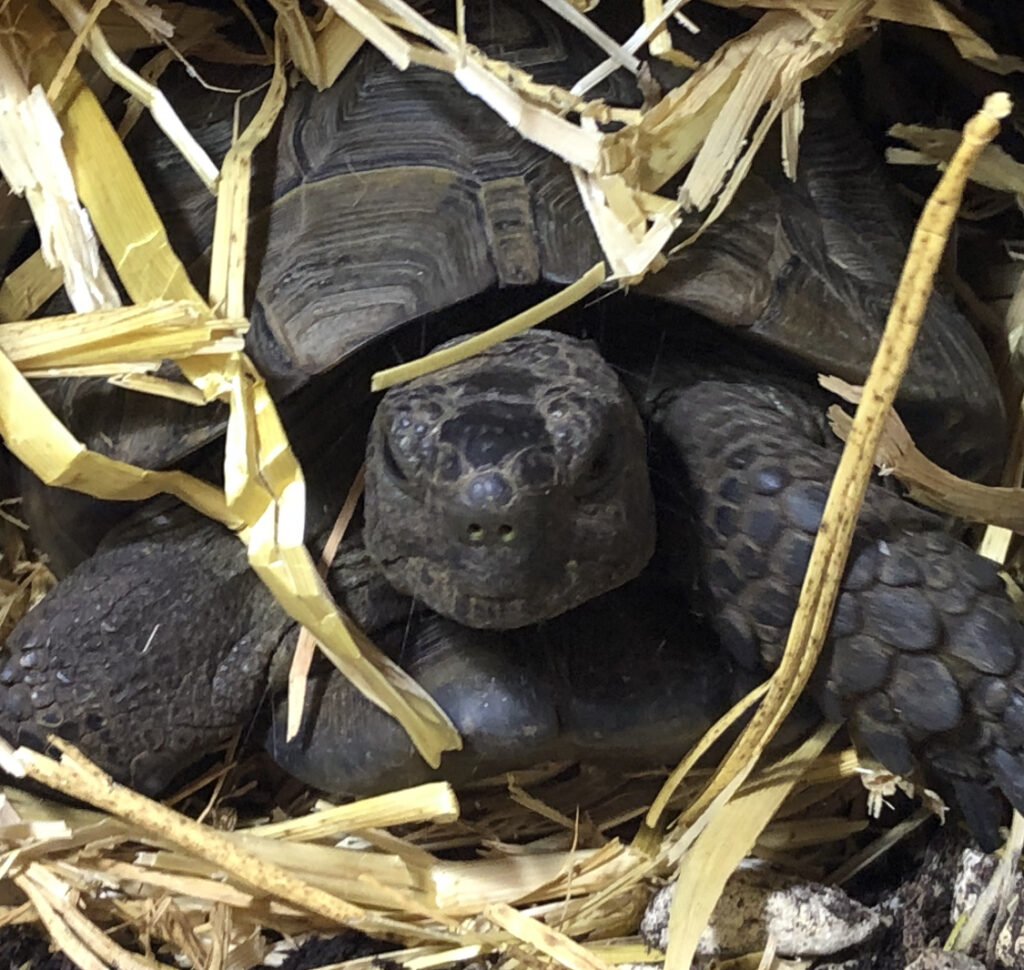
Fig. 18. Spring awakening of Testudo graeca in cold frame.
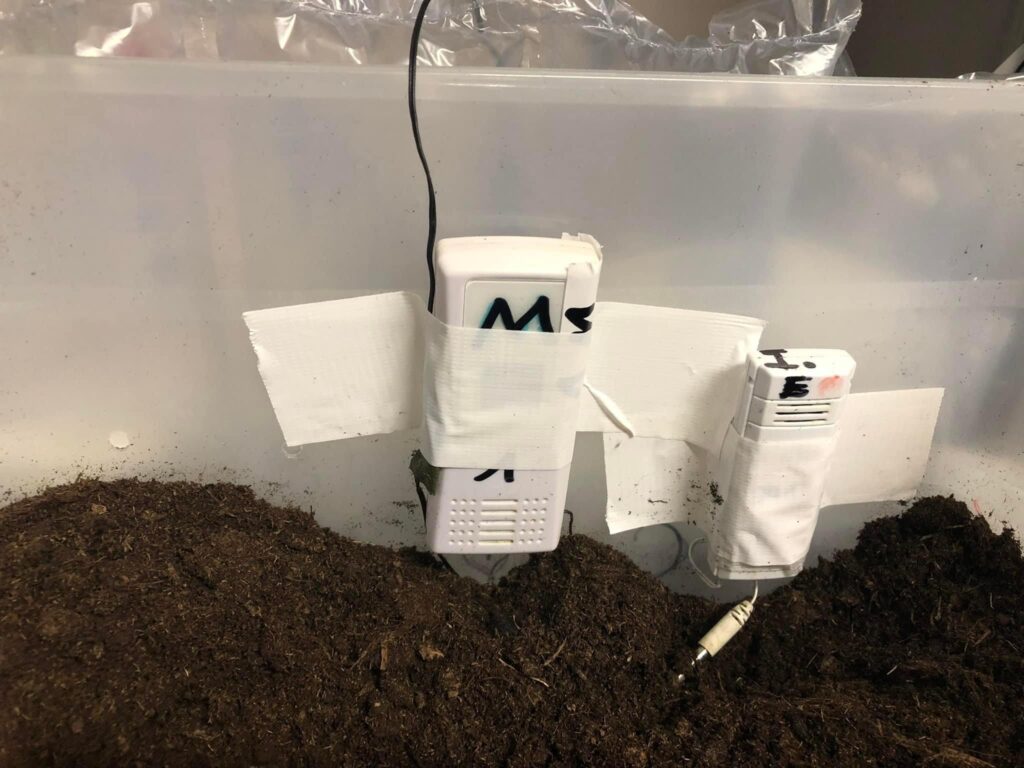
Fig. 19. Placement of the temperature sensors.
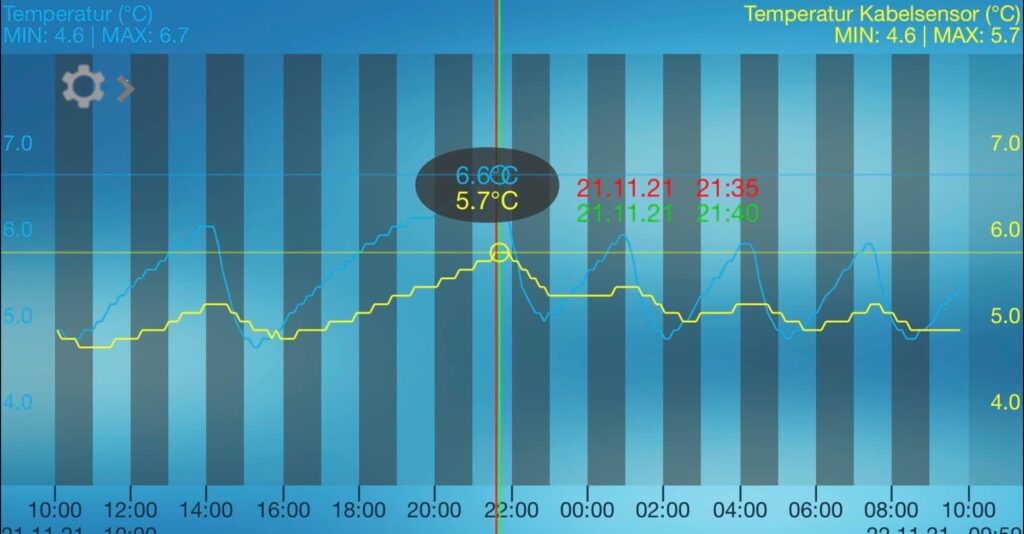
Fig. 20. Temperature curve provided by Mobile Alerts smart thermometer app.